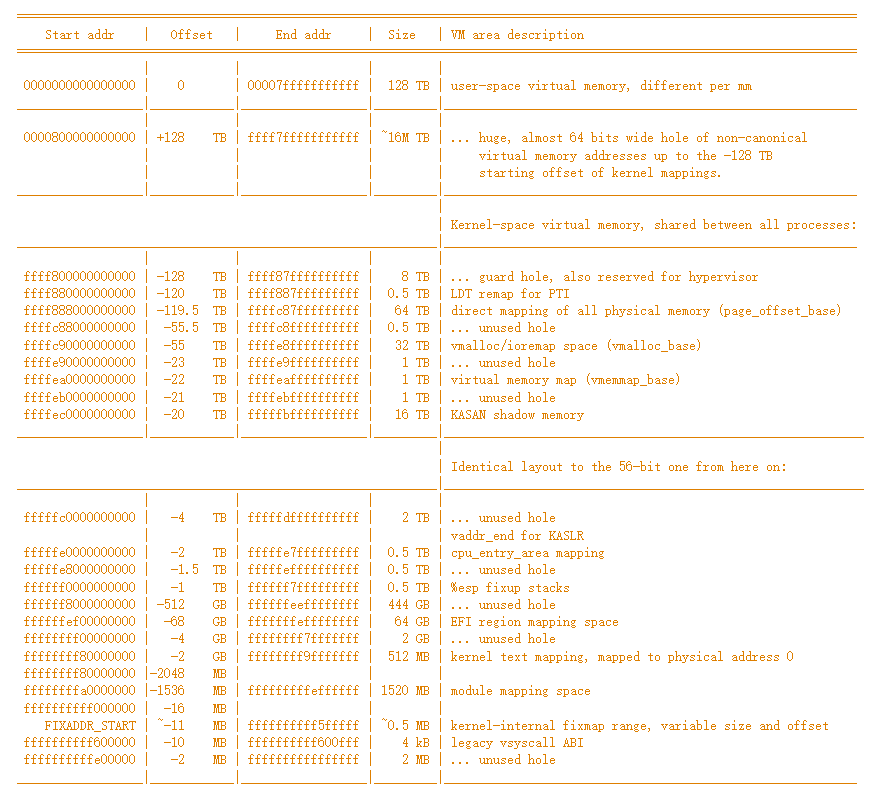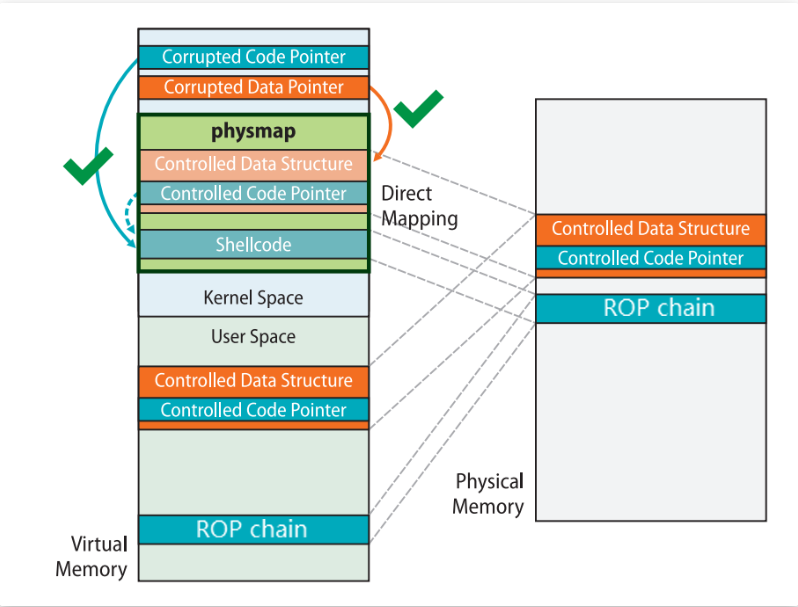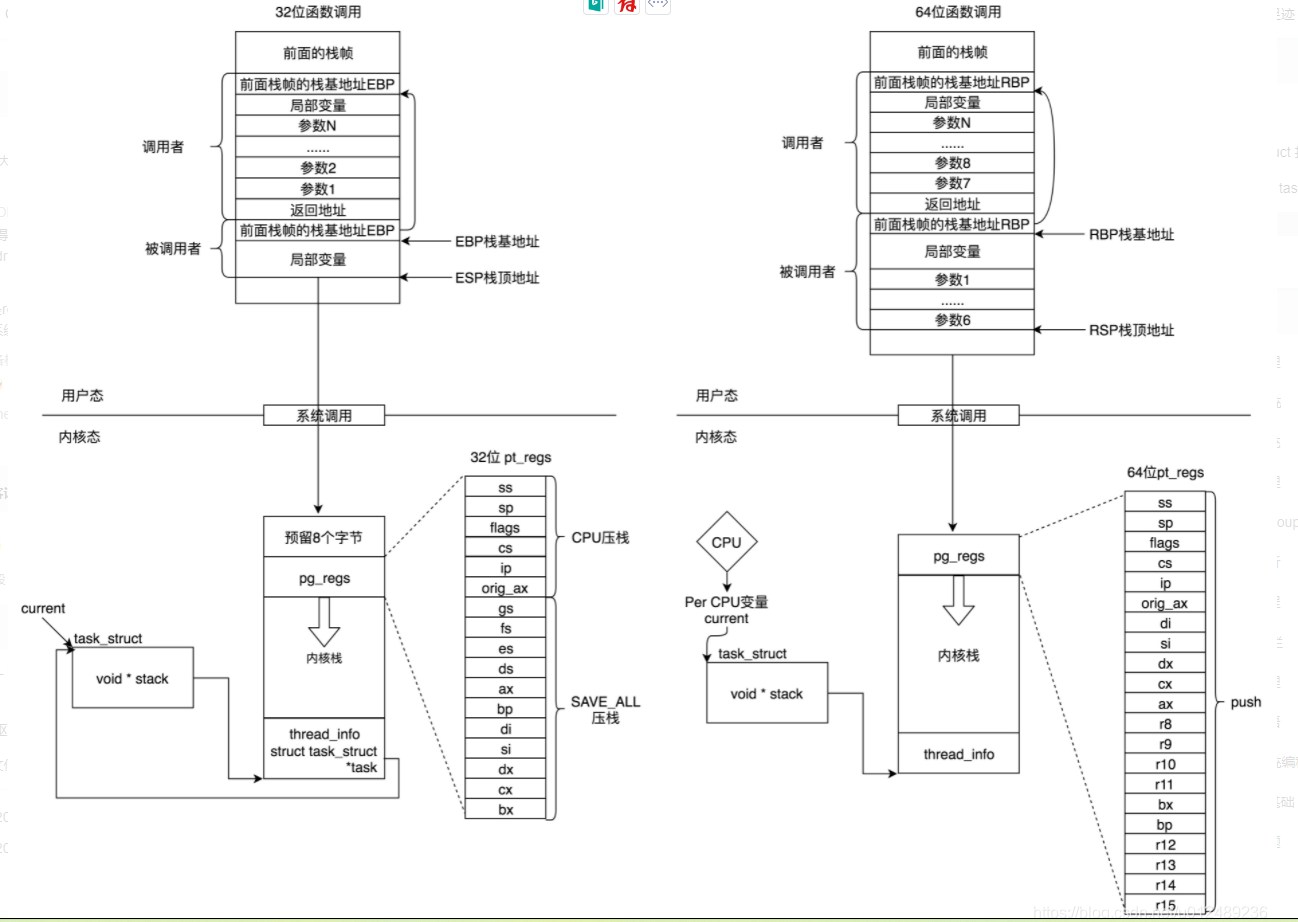更新于2022-10-13
PS: 好学者请先学习完linux内核基础 一
并完成对应习题后学习该篇内容
direct mapping of all physical memory
https://elixir.bootlin.com/linux/latest/source/Documentation/x86/x86_64/mm.rst里提出了官方的64位linux下虚拟内存布局

本节我们重点关注的是其中一项

direct mapping of all physical memory(page_offset_base)这一项,其表明的意思是,这段虚拟内存区域直接映射了整个物理内存,换句话说,这一段区域的地址和物理内存地址存在线性关系(virtual_addr = physical_addr + 0xffff888000000000
从这里也可以看出linux64位支持的最大的物理内存为64TB
同时,direct mapping of all physical memory(page_offset_base)位于内核虚拟地址空间中,那么,对于一个用户态的虚拟地址–其对应的物理地址,在内核态中也有一个虚拟地址对应。即同一个物理内存区域,可以同时通过用户态虚拟地址和内核态虚拟地址进行读写
这里存在一个攻击手段,即在用户态的虚拟地址写入shellcode/rop_chain,通过泄露内核态地址,可以实现在内核态中执行,非常的牛逼


linux内核内存分配函数
kmalloc
kmalloc申请的虚拟内存地址位于direct mapping of all physical memory物理内存映射区域,在物理上连续,于真实物理地址的差值为一个定值,存在简单的转换关系,申请大小不能超过128kb
kzalloc
kzalloc = kmalloc + 清空内存(为0)
vmalloc
vmalloc() 函数则会在虚拟内存空间给出一块连续的内存区,但这片连续的虚拟内存在物理内存中并不一定连续。由于 vmalloc() 没有保证申请到的是连续的物理内存,因此对申请的内存大小没有限制,如果需要申请较大的内存空间就需要用此函数了。
__get_free_pages:
于kmalloc一样,申请的虚拟地址位于direct mapping of all physical memory区域,是提供给调用者最底层的内存分配函数,基于buddy system实现,同样是连续的物理内存。分配粒度为页
task_struct
对于OS来说,为了能够方便的管控进程的运行情况,使用一个叫做PCB(Process Control Block)的数据结构来记录进程的所有信息
当启动一个进程后,OS会创建一个PCB结构体(声明为task_struct),当进程结束后,才会撤销。
task_struct在Linux中的<include/linux/sched.h>中被定义。
可以在该网址中越读源码:https://elixir.bootlin.com/linux/v6.0-rc5/source/include/linux/sched.h
task_struct要记录进程的所有信息,其结构也极其复杂,对于本次学习,我们只需要关注其中2个定义
struct task_struct {
struct thread_info thread_info;
...
void* stack;
...
};
thread_info 结构体中,我们需要知道其中一个定义
struct thread_info{
...
struct task_struct * task;
};
这几个定义具体有什么用,接下来会讲
进程内核栈
众所周知,栈(stack)是当今计算机系统中不可或缺的结构之一,其实,一个进程的栈分为用户栈和内核栈。在运行用户态代码时,使用的是用户栈,当进程通过系统调用等操作陷入内核态时,在内核态运行代码使用的是内核栈。
内核栈的定义如下:
union thread_union {
#ifndef CONFIG_ARCH_TASK_STRUCT_ON_STACK
struct task_struct task;
#endif
#ifndef CONFIG_THREAD_INFO_IN_TASK
struct thread_info thread_info;
#endif
unsigned long stack[THREAD_SIZE/sizeof(long)];
};
其中THREAD_SIZE的定义如下(arch/x86/include/asm/page_64_types.h arch/x86/include/asm/page_32_types.h):
//ARM架构 , 8K
#define THREAD_SIZE_ORDER 1
#define THREAD_SIZE (PAGE_SIZE << THREAD_SIZE_ORDER)
#define THREAD_START_SP (THREAD_SIZE - 8)
//ARM64架构, 16K
#define THREAD_SIZE 16384
#define THREAD_START_SP (THREAD_SIZE - 16)
//X86_64, 16K
#define THREAD_SIZE_ORDER (2 + KASAN_STACK_ORDER)
#define THREAD_SIZE (PAGE_SIZE << THREAD_SIZE_ORDER)
pt_regs
pt_regs是一个寄存器组结构,用于在用户态和内核态进行转换时,保存上下文(context)所用
struct pt_regs { //x86 32bits
unsigned long bx;
unsigned long cx;
unsigned long dx;
unsigned long si;
unsigned long di;
unsigned long bp;
unsigned long ax;
unsigned short ds;
unsigned short __dsh;
unsigned short es;
unsigned short __esh;
unsigned short fs;
unsigned short __fsh;
/*
* On interrupt, gs and __gsh store the vector number. They never
* store gs any more.
*/
unsigned short gs;
unsigned short __gsh;
/* On interrupt, this is the error code. */
unsigned long orig_ax;
unsigned long ip;
unsigned short cs;
unsigned short __csh;
unsigned long flags;
unsigned long sp;
unsigned short ss;
unsigned short __ssh;
};
64位定义如下:
struct pt_regs { //x86-64 64bits
/*
* C ABI says these regs are callee-preserved. They aren't saved on kernel entry
* unless syscall needs a complete, fully filled "struct pt_regs".
*/
unsigned long r15;
unsigned long r14;
unsigned long r13;
unsigned long r12;
unsigned long bp;
unsigned long bx;
/* These regs are callee-clobbered. Always saved on kernel entry. */
unsigned long r11;
unsigned long r10;
unsigned long r9;
unsigned long r8;
unsigned long ax;
unsigned long cx;
unsigned long dx;
unsigned long si;
unsigned long di;
/*
* On syscall entry, this is syscall#. On CPU exception, this is error code.
* On hw interrupt, it's IRQ number:
*/
unsigned long orig_ax;
/* Return frame for iretq */
unsigned long ip;
unsigned long cs;
unsigned long flags;
unsigned long sp;
unsigned long ss;
/* top of stack page */
};
既然面临着 用户栈和内核栈的转换,那么OS就需要知道用户栈和内核栈的“位置”,即如何查询到用户栈和内核栈
通过task_struct寻找内核栈(32位)
之前提到了task_struct中有 void * stack值,通过如下代码找到内核栈
static inline void *task_stack_page(const struct task_struct *task)
{
return task->stack;
}
可以通过如下的代码索引到pt_regs的位置
//processor.h (arch\x86\include\asm)
#define task_pt_regs(task) \
({ \
unsigned long __ptr = (unsigned long)task_stack_page(task); \
__ptr += THREAD_SIZE - TOP_OF_KERNEL_STACK_PADDING; \
((struct pt_regs *)__ptr) - 1; \
})
从上述代码也可以看到,pt_regs结构体被放置在内核栈的下方
因此可以通过task_struct方便地找到内核栈和pt_regs的位置,如下图所示

通过内核栈找task_struct(32位)
如上图所示,内核栈的上方(栈是自底向上增长的),存放着thread_info结构体,thread_info中存有指向task_struct的指针。
64位下cpu的task_struct/内核栈索引
64位的cpu中有一个Per-CPU变量,用来存放task_struct的指针,因此不再需要thread_info进行索引
32位和64位的不同由下图表示:

图大多出自内核栈和用户栈
内核态和用户态转变(again)
现在有一定基础后,再来看看linux用户态和内核态的转变吧!
用户态->内核态
方式:
- 系统调用
- 异常(fault/trap)
- 外设中断
在发生如上情况时,os主要做了以下几件事
1. 切换gs寄存器 swapgs
2. 保存用户态栈帧信息(用户栈顶放入CPU独占变量,CPU独占变量里的内核栈顶放入rsp/esp寄存器中)
3. 保存用户态寄存器信息(push各个寄存器的值到内核栈上(pt_regs))
4. 通过汇编指令判断为32位/64位
5. 控制器转交内核,执行系统调用(sys_call_table)
内核态->用户态
1. swapgs
2. iretq/sysretq
user_shell_addr
user_cs
user_eflags
user_sp
user_ss
references
arttnba3的blog
内核栈和用户栈
kmalloc、kzalloc、vmalloc、__get_free_pages的区别
linux内存布局(官方)
一篇文章读懂mmap